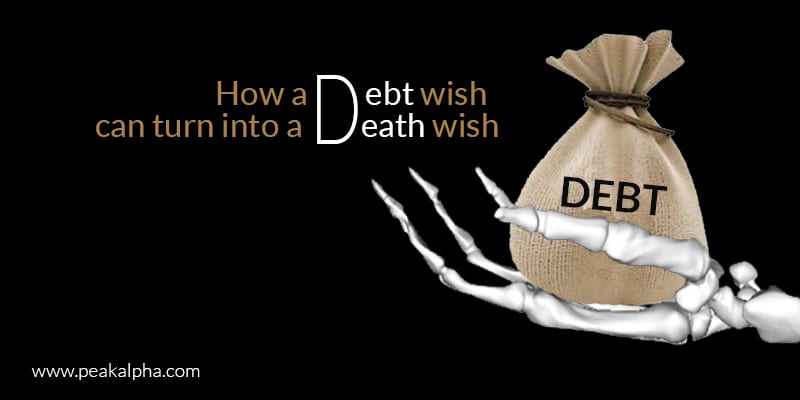- August 8, 2019
- Posted by: peakalpha2023
- Category: Livemint

By Priya Sunder, Livemint article posted on 6 August 2019
When debt far exceeds your income, you are letting yourself be sucked into a debt vortex.
My father bought his first house at 52. It was an outright purchase, no loans. I bought my first house at 28, with a home loan. Clearly, loans allow you to spend tomorrow’s money today. That is not necessarily a bad thing as it lets you fast-track a future lifestyle into the present. But if, for any reason, your income stream is disrupted, then that loan becomes a noose around your neck, tightening its grip each passing day.
Mr and Mrs X were a middle-class couple in their late 40s. Even though X earned well, the family was living pay cheque to pay cheque. Income was high, but expenses were excessive too. The family’s overall assets ran into a couple of crores but their liabilities stood at nearly the same figure. In 2019, the couple’s lives took a turn for the worse. X was diagnosed with an aggressive form of cancer. His limited corporate medical insurance could not meet his high treatment costs. To cover the gap, he redeemed fixed deposits of ₹30 lakh. His company also notified him that though they would allow him medical leave for a month, they could not guarantee his employment beyond that.
A month later, X pulled out his PF to pay his EMIs and meet routine expenses. With a monthly outflow of nearly ₹3 lakh, X depleted his assets within six months. With mounting health expenses, X took a personal loan at 16%, while using his already overstretched credit card for routine expenses. Still unfit to return to work, X is selling his only remaining asset—his home. The proceeds will still be inadequate to clear all his loans. Sensing a distress sale, the best offer he has is nearly 20% lower than the market price. The primary reason for X’s predicament is his disregard for the level of debt he could comfortably service. When debt payments exceed more than 40% of your take-home income, you are allowing yourself to be sucked into a debt vortex. Extricating yourself becomes harder when unforeseen incidents that need sudden money outflow take place. If X had taken moderate loan, his fixed payments could have been kept at a manageable level.
X’s second mistake was his inability to create adequate liquid assets. High loan payments diminished his capacity to create other assets. With the bulk of his money locked in property, liquidating it at short notice forced him to sell below the expected price.
Third, X should have directed part of his savings to reducing his loan. It is common mathematical sense to refrain from borrowing at a high cost when your existing assets grow at a lower rate. X’s FDs generated a post-tax return of 4.5%. If he had directed this money towards bringing down his home loan, he would have guaranteed himself a post-tax return of 9.8%, which was the interest he paid on his loan.
The behaviour of accumulating debt at high rates while growing assets at low rates is common. But what’s more perplexing is people holding on to cash at 3%, while harbouring compounding credit card interest of 30%. This behaviour is more pronounced among high-debt households, whose focus is more on accumulating assets rather than reducing debt, no matter how leveraged their assets may be. X had exhibited this very behavioural bias; he struggled with debt all along but continued to accumulate more loans. Towards the end, he borrowed money to fund earlier borrowings, in a sense creating a ponzi scheme of his own making. And we all know how Ponzi schemes ultimately end.
Borrowing against the future always carries a risk. Many families take on debt based on how much they can borrow. Such an approach is almost always influenced by an aspirational lifestyle, and not what is prudent and affordable. Though the pain of paying is pushed to a future date, the worry of pending payments weigh heavily on the family’s shoulders for years.
The rise of loans and credit cards have fostered an “enjoy now, pay later” world. As a generation, we may have narrowed the chasm between want and fulfilment to days, hours and minutes, but in the process, have we lost the simple joys of delayed gratification? Instead of “enjoy now, pay later”, imagine a world where you pay now and enjoy later. It’s a liberating thought. No worries about collection agents knocking on your door. No fat monthly payments that prevent you from quitting your stressful job. No gritting anxiety as you open your credit card statement.
As for me, I think I’ll book my tickets for that long cherished Mediterranean cruise and wait in tantalizing anticipation till 2022. And, of course, I will book the tickets with my debit card.

good blog and now I have learned the perfect way is to pay your installments on time.